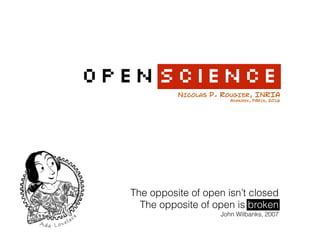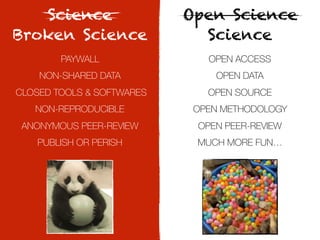Open science
- 1. NICOLAS P. ROUGIER, INRIA ADAWEEK, PARIS, 2016 The opposite of open isnât closed The opposite of open is broken John Wilbanks, 2007 OPENscience
- 2. OPEN ACCESSâĻ OPEN DATA OPEN SOURCE OPEN METHODOLOGY OPEN PEER-REVIEW MUCH MORE FUNâĶ PAYWALLâĻ NON-SHARED DATA CLOSED TOOLS & SOFTWARES NON-REPRODUCIBLE ANONYMOUS PEER-REVIEW PUBLISH OR PERISH Science Broken Science Open Science Science
- 3. OPENSCIENCE Open science is the movement to make scientiïŽc research, data and dissemination accessible to all levels of an inquiring society, amateur or professional.
- 4. OPENACCESS Annalen der Physik, vol. 18, no 13, (1905)âĻ Does the Inertia of a Body Depend upon its Energy-ContentâĻ A. EINSTEIN. Journal of the Proceedings of the Linnean Society of London. Zoology, vol. 3 (1858)âĻ On the Tendency of Species to form Varieties; and on the Perpetuation of Varieties and Species by Natural Means of Selection.âĻ C. DARWIN & A. WALLACE. Nature 171 (1953)âĻ Molecular Structure of Nucleic Acids: A Structure for Deoxyribose Nucleic AcidâĻ J.D. WATSON & F. H. C. CRICK. Communications in Mathematical Physics 43 (1975)âĻ Particle creation by black holesâĻ S.W. HAWKING. 32$ 38$ 40$ 38$
- 5. OPENACCESS Green access / Gold access / Hybrid access Nobody pays (sort ofâĶ) Author pays (a lot usually) Everybody paysâĻ (what the fâĶ?)
- 6. OPENACCESS
- 7. OPENDATA Open data may include non-textual material such as maps, genomes, connectomes, chemical compounds, mathematical and scientiïŽc formulae, medical data and practice, bioscience and biodiversity (wikipedia) âDatasets are available upon request by contacting the corresponding authorâ â How long will the email address last ? âĻ âCode can be found in the appendixâ â Maybe, maybe notâĶ âAll data are available from my webpageâ â 404 page not found âPseudo-code is given in table 1â â And what Iâm supposed to do with it ?
- 8. OPENDATA
- 9. OPENDATA A second concern held by some is that a new class of research person will emerge â people who had nothing to do with the design and execution of the study but use another groupâs data for their own ends, possibly stealing from the research productivity planned by the data gatherers, or even use the data to try to disprove what the original investigators had posited.There is concern among some front-line researchers that the system will be taken over by what some researchers have characterized as research parasites âĻ The New England Journal of Medicine (2016) Open data is the idea that some data should be freely available to everyone to use and republish as they wish, without restrictions from copyright, patents or other mechanisms of control. FAIR Data : Findable, Accessible, Interoperable, Re-Usable
- 10. OPENMETHODOLOGY
- 11. OPENMETHODOLOGY The (ugly) hacking way: p=0.052, click, click, click, p=0.049, save The (bad) excel way: click, click, select, click, click, move, del, click, re- click, save, unclick, ctrl-z, ctrl-z, click, enter, click, click, move, click, re-click, save The (good) reproducible way: >>> data = load(âdata.txtâ) >>> mean, std = data.mean(), data.std() >>> file = file.open(âanalysis.txtâ) >>> write(âmean: %f, std: %fâ % (mean, std)) >>> exit() $ git commit -a -m âComputed results from 24/11/2016â I have heard from graduate students opting out of academia, assistant professors afraid to come up for tenure, mid-career people wondering how to protect their labs, and senior faculty retiring early, all because of methodological terrorism. APS Observer (2016)
- 12. OPENMETHODOLOGY
- 13. OPENSOURCE WHAT ELSE ? I consider that the Golden Rule requires that if I like a program I must share it with other people who like it. Software sellers want to divide the users and conquer them, making each user agree not to share with others. I refuse to break solidarity with other users in this way.âĻ GNU Manifesto, Richard M. Stallman, 1985
- 14. OPENSOURCE WHAT ELSE ? github : the open-source way to host, create and curate knowledge Margaret Hamilton Director of the Software Engineering DivisionâĻ https://github.com/chrislgarry/Apollo-11
- 15. OPENREVIEW Nature 333 (1988) Human basophil degranulation triggered by very dilute antiserum against IgE E. DAVENAS, F. BEAUVAIS, J. AMARA, M. OBERBAUM, B. ROBINZON, A. MIADONNAI, A. TEDESCHI, B. POMERANZ, P. FORTNER, P. BELON, J. SAINTE-LAUDY, B. POITEVIN & J. BENVENISTE Social Text, 46/47 (1996)âĻ Transgressing the Boundaries: Toward a TransformativeâĻ Hermeneutics of Quantum Gravity A. SOKAL International Journal of Advanced Computer Technology (2014)âĻ Get Me OïŽ Your Fucking Mailing ListâĻ D. MAZIÃRES & E. KOHLER Unpublished (1993)âĻ The dynamics of interbeings and monological imperatives inâĻ Dick and Jane: a study in psychic translational gender modes âĻ CALVIN & HOBBES Copyright (c) 1993 Bill Waterson
- 16. OPENREVIEW
- 17. OPENREVIEW
- 18. OPENEDUCATION Open education is a collective term to describe institutional practices and programmatic initiatives that broaden access to the learning and training traditionally offered through formal education systems.
- 19. NEWPLAYERS ORCID (Open Researcher and Contributor ID) is a nonproprietary alphanumeric code to uniquely identify scientiïŽc and other academic authors and contributors Figshare is an online digital repository where researchers can preserve and share their research outputs, including ïŽgures, datasets, images, and videos. Zenodo is a research data repository created by OpenAIRE and CERN to provide a place for researchers to deposit datasets. ArXiv is a repository of electronic preprints of scientiïŽc papers in the ïŽelds of mathematics, physics, astronomy, computer science, quantitative biology, statistics, and quantitative ïŽnance, which can be accessed online. GitHub is a web-based Git repository hosting service that offers all of the distributed version control and source code management functionality of git as well as adding its own features. And many more to discover (RIO journal, F1000, The Winnover, Jupyter project, Software & Data carpentry, etc.)
- 20. successstory (SELF-ADVERTISEMENT) Measuring Reproducibility in Computer Systems ResearchâĻ Colbert et al. (2014)
- 21. successstory We redo Science ! ReScienceReproducible science is good. Replicated science is better. OPEN DATA OPEN SOURCE OPEN PEER-REVIEW OPEN (GREEN) ACCESS NO âBUZZâ BARRIER COMMUNITY SUPPORTED 0⎠BUDGET (SELF-ADVERTISEMENT)
- 22. successstory (SELF-ADVERTISEMENT) ReScience | | | ReScience Ï 1 Ã 4 4 Ã 1 4 Ã 4 1 Ã 4 4 Ã 1 4 Ã 4 1 Ã 4 4 Ã 1 1 Ã 4 4 Ã 1 1 Ã 4 4 Ã 1 Vi 4 (1, i) â (1, i) (i, 1) â (i, 1) | | |
- 23. NEWincentives But mostly, Open Science is good for you Data citation & Software citationâĻ (recognition, collaboration, track use and re-use, etc.) Alternative metricsâĻ (Altmetrics, Depsy, PLOS ALMS, Plum analytics, etc.) New publishersâĻ (F1000, GigaScience, RIO, PeerJ, ReScience, etc.) European Open Science AgendaâĻ (foster open science, remove barriers, develop infrastructureâĻ mainstream access, embed Open Science in society) Growing concern on reproducibilityâĻ (PubPeer, ReScience, p-hacking, etc.)
- 24. âMy work on free software is motivated by an idealistic goal: spreading freedom and cooperationâ âĻ GNU founder (1985)âĻ Richard M. Stallman OPEN HERO
- 25. âFor me, the repository was supposed to be a three-hour tour, not a life sentenceâ âĻ ArXiv founder (1991)âĻ Paul Ginsparg OPEN HERO
- 26. âRight now, copyright legislation is so complicated and varies so much from country to country that many people simply choose to ignore itâ âĻ European copyright reform (2015) âĻ Julia Reda OPEN HERO
- 27. âInformation is power. But like all power, there are those who want to keep it for themselvesâ âĻ Guerilla Open Access Manifesto (2008)âĻ Aaron SwarztâĻ 1986-2013 OPEN HERO
- 28. âMy original concept was to provide a free encyclopedia for every single person in the worldâ âĻ Wikipedia co-founder (2001) âĻ Jimmy Wales OPEN HERO
- 29. âJournal paywalls are an example of something that works in the reverse direction, making communication less open and efficientâ âĻ Sci-Hub founder (2011) âĻ Alexandra Elbakyan OPEN HERO
- 30. Merck cooked up a phony, but real sounding, peer reviewed journal and published favorably looking data for its products in them. Merck paid Elsevier to publish such a tome (2003) SOME VILlAIN
- 31. The publishers Springer and IEEE are removing more than 120 papers from their subscription services after a French researcher discovered that the works were computer-generated nonsense (2014) SOME VILlAIN
- 32. Wiley is using fake DOIs to trap web crawlers and researchers. Wileyâs fake DOIs are not stable, and create the potential for DOI collisions, which break the system (2016) SOME VILlAIN
- 33. Quantitative metrics, grant funding, diversity challenge, gender bias, resistance to change, science careers, etc. SOME VILlAIN
- 34. DATAREVIEW SOURCEACCESSEDUCATION METHODOLOGY OPENSCIENCE Questions? COMMENTS? All ADA pictures fromâĻ âLovelave & BabbageââĻ by Sydney Padua


































